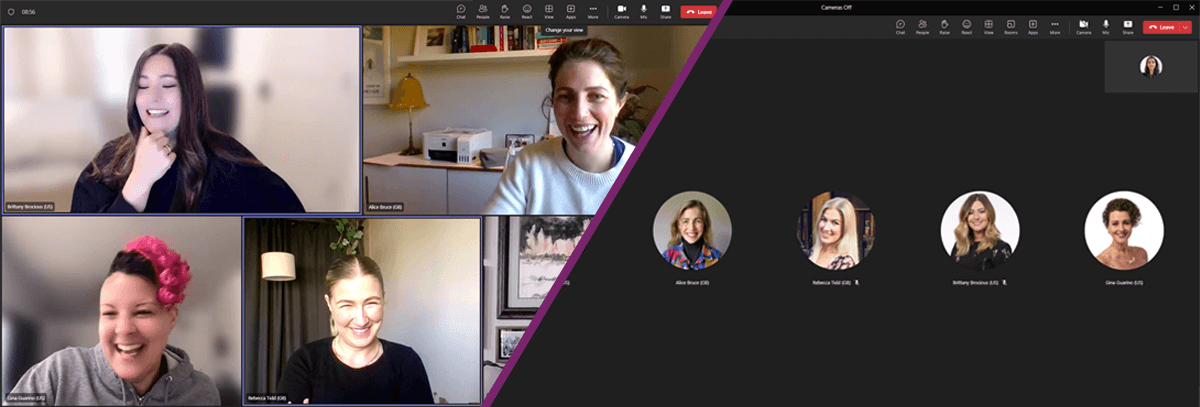A few years ago, it would have been difficult to imagine a world where virtual meetings would be the norm rather than the exception. Yet, today, they are a commonplace feature of modern-day work culture for millions of remote and hybrid workers and to all of us in the meetings and events industry.
We know that virtual meetings will continue to play a role in business communication and it’s important to take the time to understand the potential impact that this relatively new technology can have on our wellbeing, particularly with regards to the use of cameras. In this article, we explore the pros and cons of video conferences and share some helpful tips for both attendees and hosts to consider.
How Being on Camera Impacts Our Wellbeing
Human Connection
In the depths of lockdown, when social interaction was limited and most people were spending the majority of their time at home, having cameras on during virtual calls became the norm for many businesses. Interacting with people on screen encouraged a more authentic form of human connection – one that naturally helped to alleviate feelings of isolation and to promote higher levels of engagement. Fast forward a few years and these benefits continue to apply to many remote teams, and especially for people working from home alone.
Having cameras on when meeting a new colleague or client can also make a big difference to forging relationships. Showing a friendly face can help to break the ice and make people feel more at ease and allows your audience to establish a visual memory that moves you away from ‘stranger’ status, and closer to being a familiar and trusted person.
Non-verbal cues
If we’re unable to see the person we are speaking to, it’s easy to miss out on important cues that would usually be communicated through facial expressions and body language. When we interact with someone in person or on camera, we’re able to intuitively perceive their thoughts and feelings. Whether they’re nodding in approval, furrowing their brow in confusion, or perhaps smiling to suggest sarcasm, these non-verbal cues provide valuable context that help to reduce feelings of anxiety or stress that may arise from miscommunication.
They are particularly valuable in gauging when someone has finished speaking, or when it’s appropriate to interject or ask a question. A change in posture, a subtle hand gesture or even a slight raise of the eyebrows can signal that someone has finished talking – eradicating the awkwardness of multiple people speaking at once and ultimately leading to more natural and effective communication.
Related article: The Importance of Video in Your Live or Virtual Event
Morning Motivation
Numerous studies have proven that there is a direct link between getting dressed for the day and our general mental state. Many people will carry out their usual morning routine of getting showered and dressed, regardless of whether they’re leaving the house or attending a virtual meeting. But that may not be the case for everyone.
The prospect of being on camera may help to encourage some remote workers to freshen up in the morning. Even if it’s in designated WFH loungewear, it helps to feel more motivated, more confident and better prepared for the day ahead.
‘Zoom fatigue’
This term became a part of the pandemic lexicon in early 2020 and remains relevant for people using any type of video conferencing platform today. It refers to the feeling of exhaustion or burnout that can be experienced after spending prolonged periods of time in video conferences. It’s been a significant topic of conversation in the world of virtual meetings, and one that attracted some worthy research.
In October 2021, Harvard Business Review conducted a valuable study (Research: Cameras On or Off?) on how being on camera was impacting the wellbeing of working professionals. The study concluded that using the camera was positively correlated to daily feelings of fatigue; the number of hours that employees spent in virtual meetings were not. This indicated that keeping the camera consistently on during meetings was at the heart of the fatigue problem. Furthermore, once people began experiencing these feelings, they were less likely to engage and to contribute to the conversation – undermining the primary purpose of being on camera in the first place.
All eyes and ears
Partly to blame for ‘Zoom Fatigue’ is our inherent nature to perform when on camera. We’re not talking about the Friday night team karaoke call here, but about the instinctive need to appear alert, engaged and interested when someone is speaking on screen. When we attend meetings in person, our shared surroundings allow us to look away from someone’s face without seeming any less present but when we’re on video, looking away from our screen might be misinterpreted as a lack of interest. This concerted effort to keep our eyes on the screen at all times can lead to sensory overload without us even realising, and is the reason why many remote workers opt to turn self-view off during video calls.
Our subliminal effort to appear engaged on camera can not only drain our energy, but it can distract us from achieving meaningful outcomes from our meetings. Therefore, to be or not to be on camera is not the question but, rather, how can we create virtual environments that encourage and enable participants to achieve the best possible outcomes?
At BCD M&E, we believe it’s important for everyone to be aware of the potential impact using cameras may have on our wellbeing, and of the value they bring to a virtual meeting. From an internal standpoint, it is equally important for managers to engage in open discussions about their team’s preferences and concerns, before setting any expectations or requirements. By prioritising the needs and perspectives of all participants, our meetings are bound to be more productive and more likely to contribute to the overall success of our teams and the wider business.
References
For more information on the study referenced in this article, visit:
Research: Cameras On or Cameras Off by Harvard Business Review
Originally published Apr 4, 2023 4:52:38 AM




